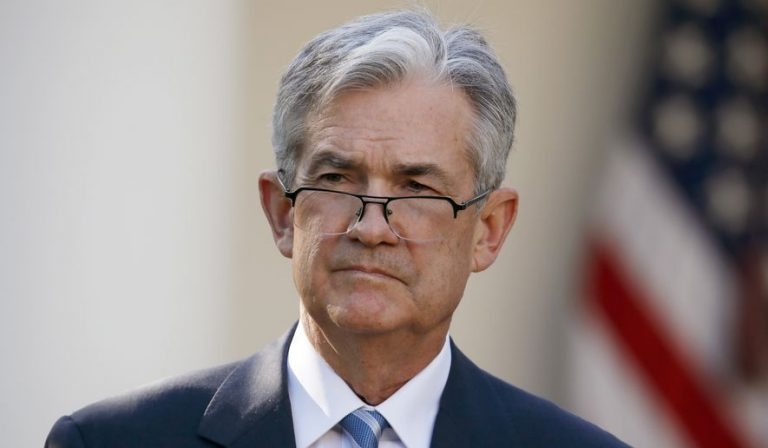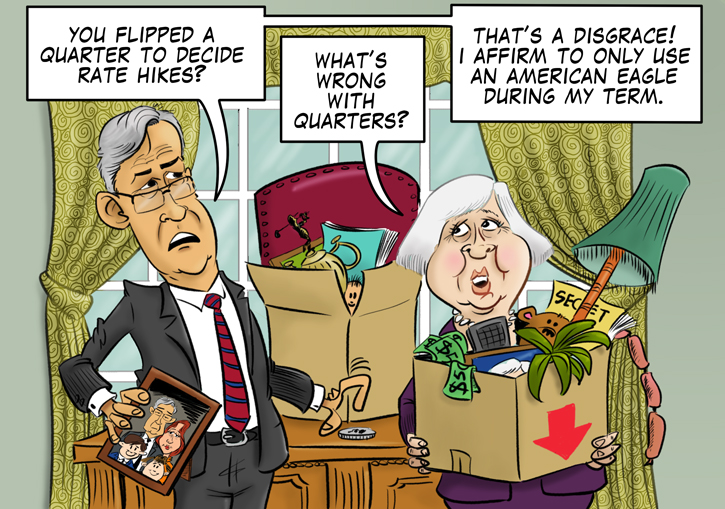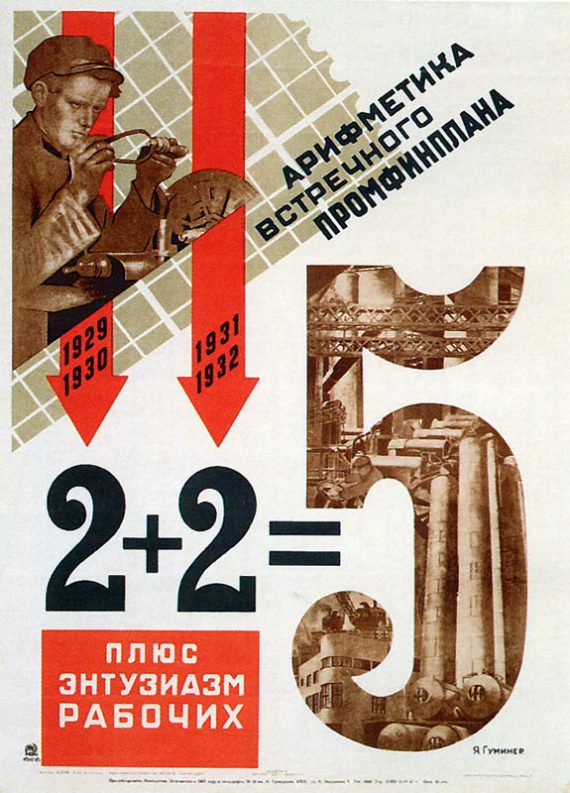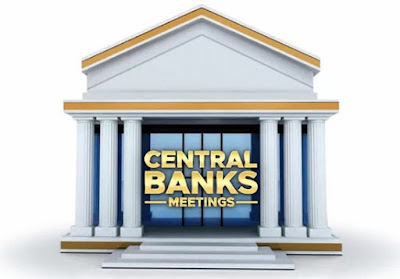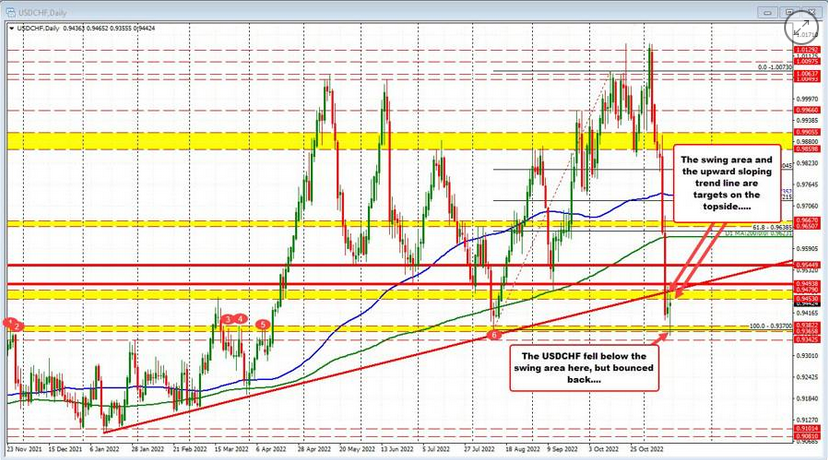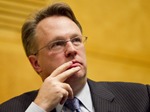Ridiculous MinutiaJerome Powell, the new Chairman of the Federal Reserve, just completed his third week on the job. He’s hardly had enough time to learn how to operate the office coffee maker, let alone the all-in-one printer. He still doesn’t know what roach coach menu items induce a heinous gut bomb.
|
The perpetually slightly worried looking new Fed chairman Jerome Powell, here seen warily inspecting the Rose Garden at the White House. Everybody wants to know if he has a “better plan” – but there is no better plan, thus no-one has one. |
| Yet across the planet, folks high and low are already telling him exactly how he should do his job. What’s more, they’re passing advance judgment on things that may or may not happen. For example, the South China Morning Post recently offered the following opinion:
When Powell showed up to work on February 5, for his first day on the job, the general consensus was that the Fed would raise the federal funds rate three times this year, at 25 basis points – or 0.25 percent – per increase. But now that consumer prices are rising at an annual rate of 2.1 percent, average hourly earnings are increasing at an annual rate of 2.9 percent, and Congress has passed a massive two year budget deal, twitchy economists are questioning if three rate hikes will be enough to keep inflation in check. Over the last two weeks their chants for four rate hikes in 2018 have grown louder. Goldman Sachs has even floated the five rate hike scenario. Alas, this is the sort of ridiculous minutia that policy makers and analysts must navel-gaze over in a planned economy. The truth is, Powell can’t win regardless of what he does. Whether he raises rates three times or four times – or ten times – he’ll get it wrong. Here’s why… |
Leaving aside the fact that there actually shouldn’t even be such a thing as an “interest rate policy”, this is actually not worse than any other method. |
Chronic ShortagesThe economy is a complex living organism that’s continuously evolving and always subject to change. One relationship at one moment can be completely different at another moment. Supply and demand are incessantly adjusting and readjusting to meet the conditions of the market. These continuous interactions provide a natural and efficient response to supply shortages and gluts. Even in a moderately free market economy, bakeries do not run out of bread when there is a wheat crop shortage due to a late season frost. The shelves never go empty. Rather, the price of bread rises and consumers adjust their spending accordingly. Centrally planned economies, on the other hand, are inclined to frequent, intensive and chronic shortages. Bureaucrats, armed with spiral bound planning reports and pie graphs, are incapable of fixing the proper prices for gumballs and gasoline by diktat. There’s simply too much going on and too many moving parts for them to consider. With the best of intentions, the noble planner makes their best guess of the appropriate price control. Then things invariably go haywire. In practice, the supply of certain goods or commodities may be more than adequate. But when a price administrator enforces an artificially low price, consumers are prone to wasteful behavior. They’re compelled to demand a greater amount than is supplied. Hence, the store shelves remain perpetually empty. Certainly, uniform standards work well for units and measurements. They’re critical to building consistency and standardization of hardware and parts. They’re even necessary to effective communication and computer programming. For certain things, however, uniform standards come up short… |
 In 1920, almost a century ago (!), Ludwig von Mises published a monograph entitled Economic Calculation in the Socialist Commonwealth. - Click to enlarge This small booklet showed that it was literally impossible to replace a market economy with a centrally planned one that lacked market-determined prices for capital goods. At least it is impossible for such an economy to be rational – it is doomed to eventually consume all previously accumulated capital. In the end, the division of labor will collapse and people will return to living from hand-to-mouth in small, isolated communities. Mises on purpose discussed only the case of a nationalization of the “means of production”, as this central demand was a common feature of all forms of socialism in his time. However, his ideas on the issue can be applied to a variety of cases. Central banking in particular represents a special case of the socialist calculation problem pertaining to the monetary and financial realm. It is just as impossible to be successful in centrally planning money and interest rates as anything else. It is not only pointless, it is dangerous. |
Haunted by Ghosts of the Old Eastern BlocWhen it comes to the pricing of goods, commodities and services, commanding fixed prices by a central authority is an utter failure. This was effectively proven by the experiences of the centrally planned economies of the old communist Eastern Bloc countries during the second half of the 20th century. Regrettably, price controls don’t stop with just goods, commodities, and services. The United States, Europe, and Japan have been doing their darnedest during the early years of the 21st century to show that these ghosts of the old Eastern Bloc also haunt credit. Remember, credit, like a commodity or good, has a price attached to it. The price of credit is the rate of interest a lender charges to a borrower. Like fixing the price of a commodity or good by a central planning authority, fixing the price of credit by a central bank – such as the Federal Reserve, European Central Bank, or Bank of Japan – is presently also being shown to be an utter failure. |
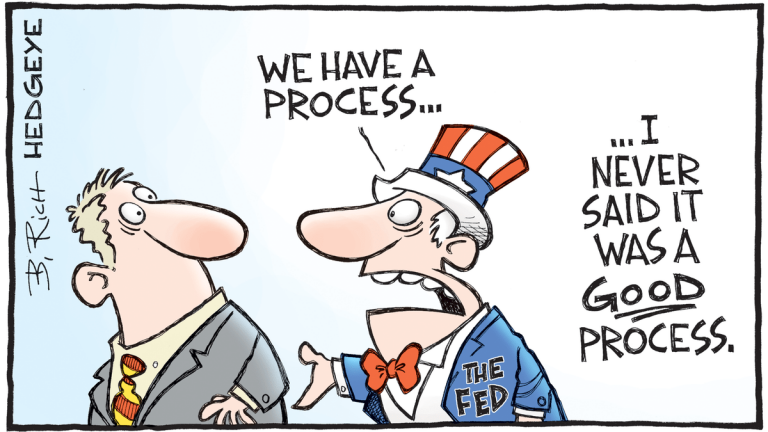 Once again, it has to be stressed that this mythical “good process” simply does not exist. - Click to enlarge Even if one assumes the central planners to all be selfless angels with nothing but the common good on their mind, they will still be unable to overcome the socialist calculation problem (in the wider sense). No matter what they decide, the outcome will always be inferior to a market-determined outcome. |
| Someone with even a dim perception of the world around them can peer out and discern many strange and grotesque occurrences: Housing prices that far outpace incomes. Total household debt at $13.5 trillion. And an entire generation of millennials that took on $1.4 trillion in student loan debt for college degrees that have been debased in stature to what a high school diploma represented for prior generations.
These represent gross misallocation of capital. What’s more, they would never have come into existence or ballooned out to this magnitude without the Fed’s credit market price controls. |
Industrial Production: Business Equipment, Jan 1997 - 2018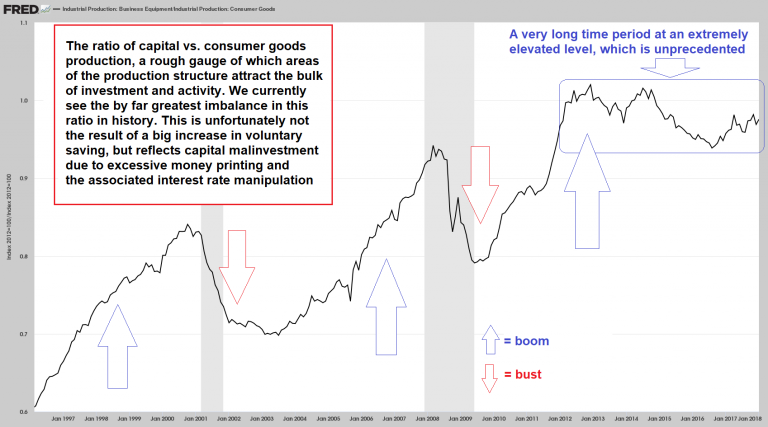 The ratio between capital and consumer goods production – a chart we use to illustrate shifts in the economy’s capital structure (between the higher and lower stages of production). - Click to enlarge Money printing and interest rate manipulation create price distortions, as relative prices in the economy are altered. The resultant falsification of economic calculation leads to artificial boom conditions, which “feel good”, but actually mask capital consumption. The latter can masquerade as “profits” for many years. These accounting profits are illusory, as was quite recently demonstrated in the housing bubble and bust: the very industries that were hailed as the economy’s “profit centers” during the boom were de facto bankrupt when the boom ended. Then they were bailed out at great cost to society at large, i.e., various innocent bystanders, particularly those who had acted more prudently. An even bigger and more persistent artificial boom was launched in response to the situation the previous boom brought about. Today the world is drowning in even more debt, the supply of money has been vastly inflated and it is certain that even more scarce capital has been consumed. |
| Fed Chairman Powell doesn’t stand a chance. Bernanke and Yellen before him oversupplied the economy with cheap credit. Now Powell must mop it up with higher interest rates. And yet, because the U.S. Economy has been pushed to the brink with record debt levels it simply cannot afford higher interest rates.
Without question, Powell will find the breaking point. Just keep in mind, when the next great liquidity crisis hits it won’t be a failure of free market capitalism. It will be a failure of the central planners and the system they wrought. |
Stalin’s minions weren’t quite as arithmetically challenged as the “2+2=5” equation seems to suggest; the idea was to get people to “fulfill the targets of the five-year plan” in four rather than in five years (no bonus payments, sorry comrades… but you’ll all be “heroes of the Soviet Union”!). The Soviet Union indeed achieved enormous increases in industrial production under Stalin’s first several 5-year plans – while at the same time managing to starve millions of alleged “Kulaks” to death. Anyone visiting the Eastern Bloc and looking at shops there (beset by long queues, joyless and utterly bereft of choices), or the waiting times would-be purchasers of new cars or apartments were confronted with (easily up to two decades for people without political connections) surely had to wonder what all those wonderful increases in production had actually achieved. If anything, they demonstrated that aggregate economic statistics are often completely useless (particularly if they are published by a government that controls the entire economy). We should mention that many Western so-called intellectuals – particularly numerous prominent economists, with quite a few “Nobel Prize” winners among them – were willfully blind to these realities. Until 1989 (!), Paul Samuelson’s Economics tome contained a chart that purported to show when the Soviet economy would “overtake” the economies of the evil capitalist West. By that time, the entire COMECON was a hopelessly bankrupt, grievously polluted hell-hole beggaring the imagination. And yet, economics professor and former Fed vice-chairman Alan Blinder was still heard opining that the main question was no longer “whether we should adopt socialism, but how much of it we should adopt” – so as to make sure that we didn’t lose out against this Soviet powerhouse and its nifty tractors rusting in the fields for lack of spare parts. |
Full story here Are you the author? Previous post See more for Next post
Tags: central-banks,newslettersent









